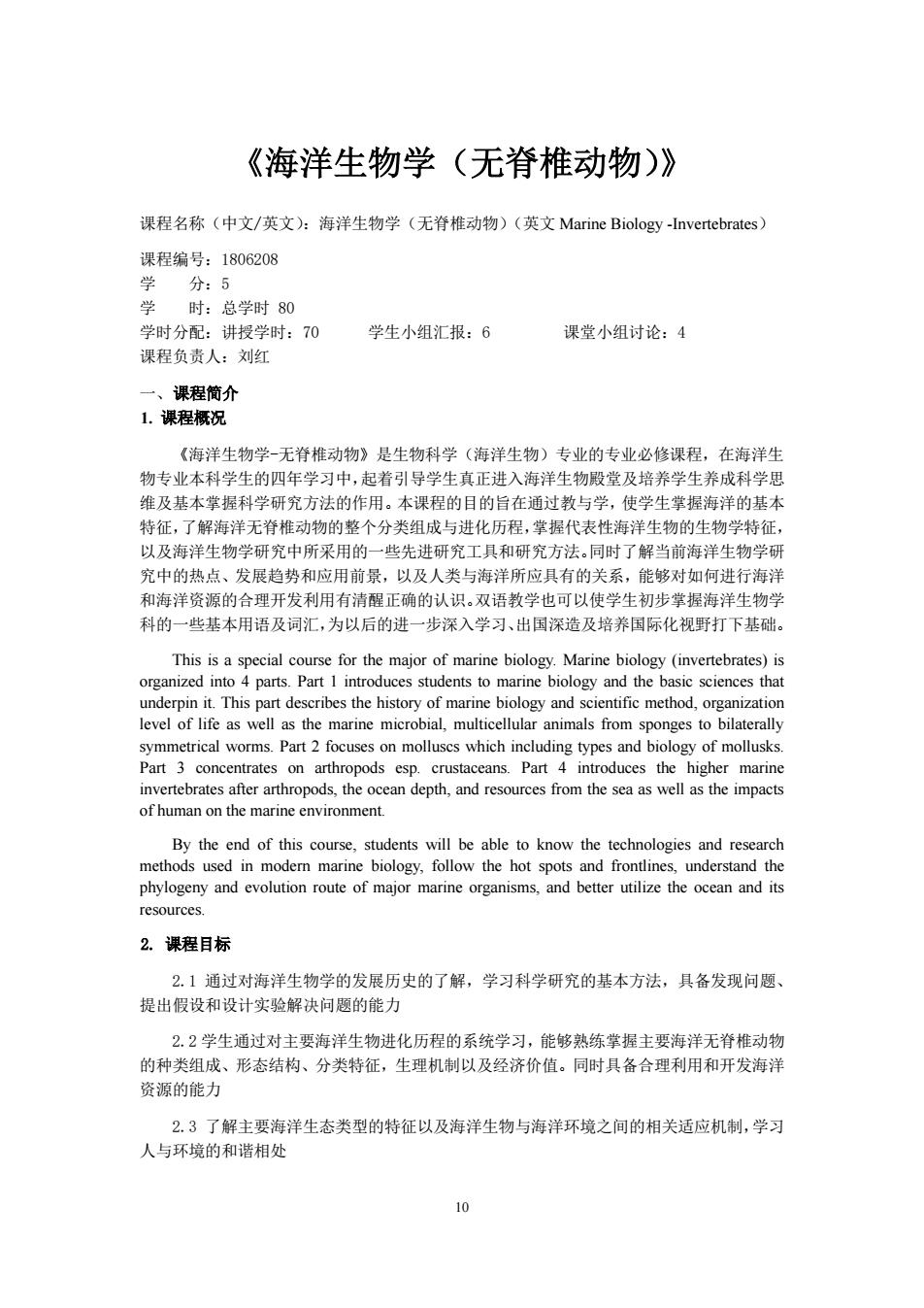正在加载图片...

《海洋生物学(无脊椎动物)》 课程名称(中文/英文):海洋生物学(无脊椎动物)(英文Marine Biology-Invertebrates) 课程编号:1806208 当 分:5 时:总学时80 学时分配:讲授学时:70 学生小组汇报:6 课堂小组讨论:4 课程负责人:刘红 一、退程简介 1.课程概况 《海洋生物学-无脊椎动物》是生物科学(海洋生物)专业的专业必修课程,在海洋生 物专业本科学生的四年学习中,起着引导学生真正进入海洋生物殿堂及培养学生养成科学思 维及基本掌握科学研究方法的作用。本课程的目的旨在通过数与学,使学生掌握海洋的基本 特征,了解海洋无脊椎 物的整个分类组成与进化历程,掌握代表性海洋生物的生物学特征。 以及海洋生物学研究中所采用的 一些先进研究工具和研究方法。同时了解当前海洋生物学研 究中的热点、发展趋势和应用前景,以及人类与海洋所应具有的关系,能够对如何进行海洋 和海洋资源的合理开发利用有清醒正确的认识。双语教学也可以使学生初步掌握海洋生物学 科的一些基本用语及词汇,为以后的进一步深入学习、出国深造及培养国际化视野打下基础。 This isa s zed int ec ial course for the bio rine biolog s that level of life as well as the marine microbial,multicellular animals from spor nges to hilaterally symmetrical worms.Part 2 focuses on molluses which including types and biology of mollusks. Part 3 concentrates on arthropods esp crustaceans Part 4 introduces the hisher marine invertebrates after arthropods,the ocean depth,and resources from the sea as well as the impacts of human on the marine environment. By the end of this course,students will be able to know the technologies and research methods used in modem marine biology,follow the hot spots and frontlines,understand the phylogeny and evolution route of major marine organisms,and better utilize the ocean and its resources. 2.课程目标 2.1通过对海洋生物学的发展历史的了解,学习科学研究的基木方法,具各发现问顺 提出假设和设计实验解决问的能力 2.2学生通过对主要海洋生物进化历程的系统学习,能够熟练掌握主要海洋无脊椎动物 的种类组成、形态结构、分类特征,生理机制以及经济价值。同时具备合理利用和开发海洋 资源的能力 2.3了解主要海洋生态类型的特征以及海洋生物与海洋环境之间的相关适应机制,学习 人与环境的和谐相 10 10 《海洋生物学(无脊椎动物)》 课程名称(中文/英文):海洋生物学(无脊椎动物)(英文 Marine Biology -Invertebrates) 课程编号:1806208 学 分:5 学 时:总学时 80 学时分配:讲授学时:70 学生小组汇报:6 课堂小组讨论:4 课程负责人:刘红 一、课程简介 1. 课程概况 《海洋生物学-无脊椎动物》是生物科学(海洋生物)专业的专业必修课程,在海洋生 物专业本科学生的四年学习中,起着引导学生真正进入海洋生物殿堂及培养学生养成科学思 维及基本掌握科学研究方法的作用。本课程的目的旨在通过教与学,使学生掌握海洋的基本 特征,了解海洋无脊椎动物的整个分类组成与进化历程,掌握代表性海洋生物的生物学特征, 以及海洋生物学研究中所采用的一些先进研究工具和研究方法。同时了解当前海洋生物学研 究中的热点、发展趋势和应用前景,以及人类与海洋所应具有的关系,能够对如何进行海洋 和海洋资源的合理开发利用有清醒正确的认识。双语教学也可以使学生初步掌握海洋生物学 科的一些基本用语及词汇,为以后的进一步深入学习、出国深造及培养国际化视野打下基础。 This is a special course for the major of marine biology. Marine biology (invertebrates) is organized into 4 parts. Part 1 introduces students to marine biology and the basic sciences that underpin it. This part describes the history of marine biology and scientific method, organization level of life as well as the marine microbial, multicellular animals from sponges to bilaterally symmetrical worms. Part 2 focuses on molluscs which including types and biology of mollusks. Part 3 concentrates on arthropods esp. crustaceans. Part 4 introduces the higher marine invertebrates after arthropods, the ocean depth, and resources from the sea as well as the impacts of human on the marine environment. By the end of this course, students will be able to know the technologies and research methods used in modern marine biology, follow the hot spots and frontlines, understand the phylogeny and evolution route of major marine organisms, and better utilize the ocean and its resources. 2. 课程目标 2.1 通过对海洋生物学的发展历史的了解,学习科学研究的基本方法,具备发现问题、 提出假设和设计实验解决问题的能力 2.2 学生通过对主要海洋生物进化历程的系统学习,能够熟练掌握主要海洋无脊椎动物 的种类组成、形态结构、分类特征,生理机制以及经济价值。同时具备合理利用和开发海洋 资源的能力 2.3 了解主要海洋生态类型的特征以及海洋生物与海洋环境之间的相关适应机制,学习 人与环境的和谐相处